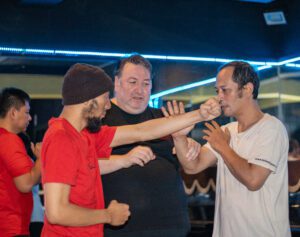Does Wing Chun Have Punches?
By Maurice Novoa a master under the Yuen Kay Shan, Ip Man and Pan Nam lineages.
Introduction:
Wing Chun is a traditional Chinese martial art known for its practical self-defense techniques and efficient movements. When it comes to hand techniques, Wing Chun offers a wide array of punches that are designed to be fast, direct, and powerful. In this article, we will explore the punches of Wing Chun and understand how they contribute to the effectiveness of this martial art.
Wing Chun’s Punches
Wing Chun incorporates various punches as part of its combat system. These punches are executed with specific principles and concepts in mind, making them highly efficient and suitable for real-life self-defense situations. Unlike punches in some other martial arts styles, Wing Chun punches focus on economy of motion, speed, and accuracy, rather than relying solely on brute force.
Straight Punch (Zuen Chui)

One of the fundamental punches in Wing Chun is the straight punch, known as “Zuen Chui.” This punch is executed with the leading hand and is directed straight towards the target in a direct line. The straight punch is quick and powerful, allowing for rapid-fire strikes while maintaining a strong centerline position. It is commonly used for close-range combat, allowing the practitioner to deliver multiple punches in quick succession.
The vertical punch of Wing Chun is delivered using a vertical fist, with the knuckles of the index and middle fingers leading the strike. This technique ensures that the punch is delivered with maximum force and minimizes the risk of injury to the hand. The straight punch in Wing Chun aims to generate power from the entire body, utilizing the rotation of the hips and the transfer of energy through the core.
Hook Punch (Gwun Chui)
Another punch commonly found in Wing Chun is the hook punch, known as “Gwun Chui.” The hook punch is delivered in a circular motion, targeting the opponent’s head or body from the side. This punch allows for effective strikes at different angles, making it useful for close-quarters combat and countering incoming attacks.
The hook punch in Wing Chun is executed with a relaxed and whipping motion, generating power from the rotation of the body and the torque generated by the hips. It is important to note that the hook punch in Wing Chun differs from the hook punches in other martial arts styles, as it does not rely heavily on swinging the arm with brute force. Instead, it focuses on speed, precision, and the ability to generate power from the core.
Uppercut Punch (Jik Chui)
The uppercut punch, known as “Jik Chui” in Wing Chun, is an upward strike delivered from a close range. This punch is designed to target the opponent’s chin, jaw, or body, exploiting openings in the opponent’s guard. The uppercut punch is effective in close-quarters combat, allowing the practitioner to strike upward with force, catching the opponent by surprise.
In Wing Chun, the uppercut punch is executed with a slight rotation of the body and a strong upward thrust from the legs and hips. The power generated in this punch comes from the coordinated movement of the entire body, allowing for a rapid and powerful strike.
Combination Punches
Wing Chun also emphasizes the use of combination punches, which involve executing a series of punches in quick succession. These combinations are designed to overwhelm the opponent and disrupt their defenses. By combining different punches with fluid footwork and precise timing, the practitioners can maintain a continuous flow of attacks, keeping the opponent off balance.
Combination punches often involve a mix of straight punches, hook punches, uppercut punches, and other hand techniques, executed with speed, accuracy, and coordination. These combinations allow for seamless transitions between different punches, maximizing the effectiveness of each strike.
Conclusion
Wing Chun incorporates a range of punches that are central to its combat system. These punches, such as the straight punch, hook punch, uppercut punch, and combination punches, are executed with specific principles and concepts in mind, emphasizing economy of motion, speed, and accuracy. By developing proficiency in these punches through dedicated practice and training, This martial arts style practitioners can deliver fast, direct, and powerful strikes in self-defense situations.
It is important to note that mastering Wing Chun’s punches requires proper instruction, practice, and a solid foundation in the fundamental principles of the art. By training under the guidance of a qualified instructor and dedicating time to regular practice, individuals can develop the skills necessary to effectively utilize these punches in real-life scenarios.

